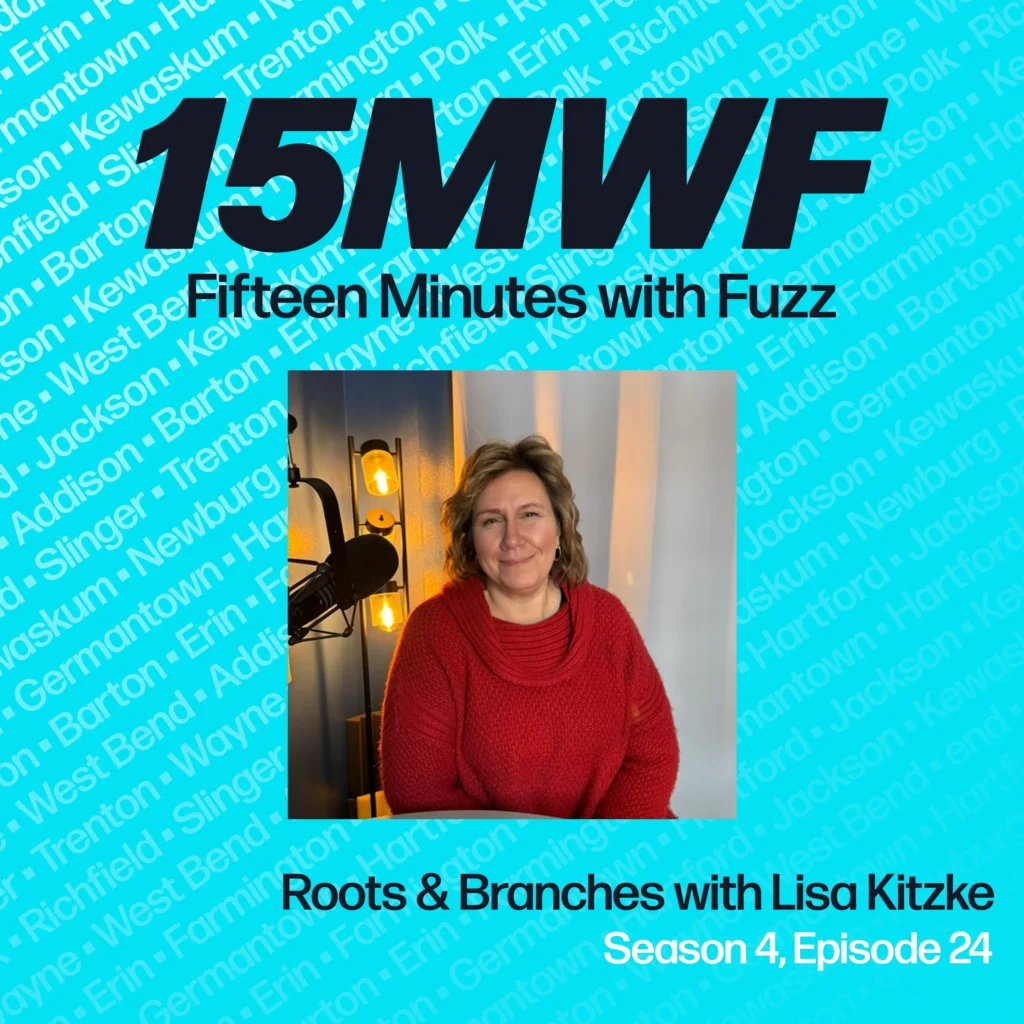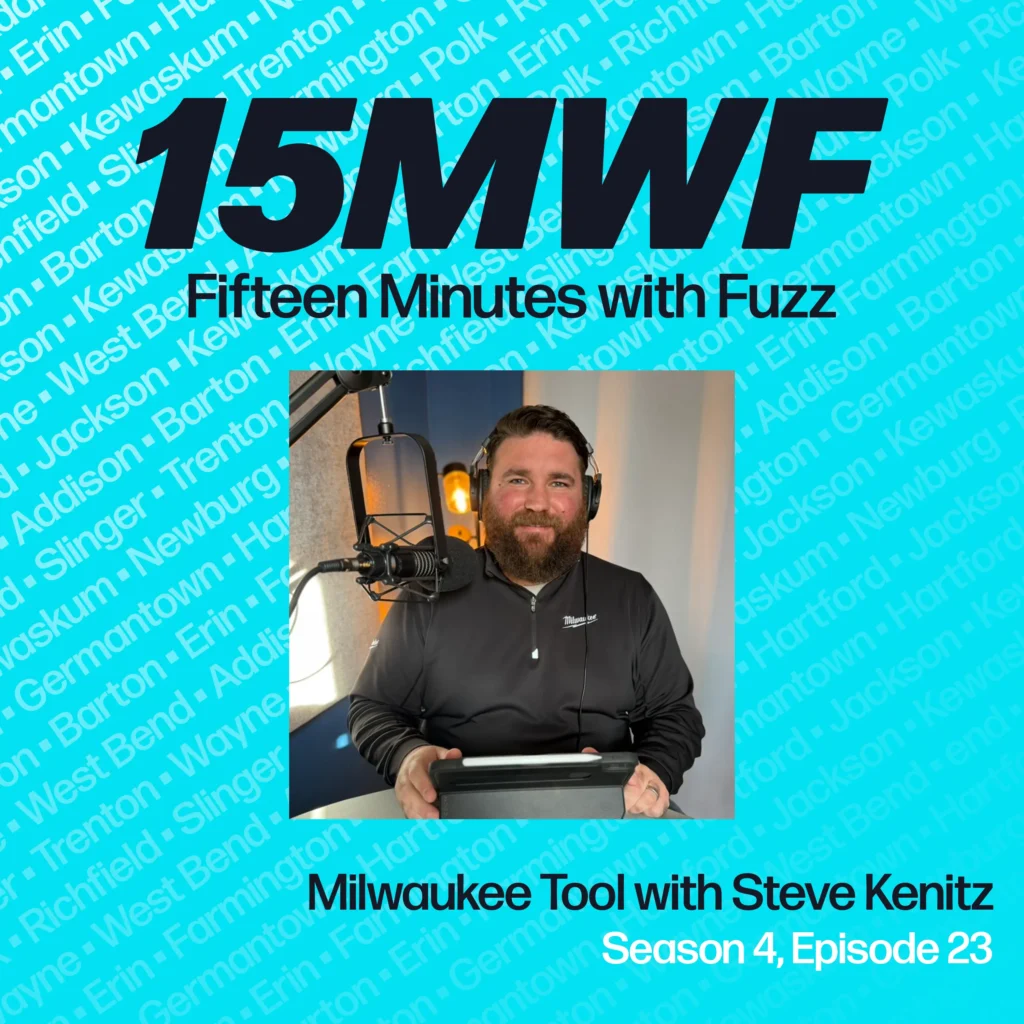One thing that Washington County has that a lot of other counties don’t is a long stretch of Wisconsin’s Ice Age Trail. On this week’s episode, Mark Muellenbach, the chapter coordinator for the Washington/Ozaukee County Ice Age Trail Alliance joins me to talk about the trail and the upcoming Mammoth Hike Challenge.

Fifteen Minutes with Fuzz
A podcast about positive things happening in and around Washington County, Wisconsin
The Washington/Ozaukee County Ice Age Trail with Mike Muellenbach
Transcript
(click to expand)[00:00:00] Fuzz Martin: Hey, thanks for listening to Fifteen Minutes with Fuzz. I’m your host, Fuzz Martin, and each week we talk about all the Fun and interesting things going on in and around Washington County, Wisconsin. Our topic this week spans all of Washington County from the north to the south and is a great piece of recreation that relies on the geological history.
of our state. Today, we’re talking about the Ice Age Trail with Mark Muellenbach, the chapter coordinator for the Washington and Ozaukee County Ice Age Trail Alliance.
So Mark, I’d hope that most people who are listening to this, who live in Washington County or the area at least, would know what the Ice Age Trail is. But if you could give us a little bit of background on what the trail is and how it came into existence for those who might not know, that would be a good way to start, I think.
[00:01:23] Mark Muellenbach: Okay, the Ice Age Trail started as a vision of a guy named Ray Zilmer back in the 50s. He was a Milwaukee attorney who enjoyed the outdoors. And he knew we had incredible glacial topography here in Wisconsin, some of the best in the world. And he envisioned a national park, the Ice Age National Park. And he was an avid hiker and he pictured a hiking trail going down the middle of that park.
Unfortunately, he passed away before he got too far with the legislative side of it. But other people picked up the pace. They got it passed. And in the 1970s, volunteers started putting trail in. There were Like in Kettle Moraine North, there were already trails there. So volunteers just started stretching it out.
And today we don’t have a national park, but we have, you know, the Kettle Moraine State Forests do a good job of preserving that glacial topography, and we have the Ice Age Trail. And for those who don’t know, it’s, you know, one end is at Pottawatomie State Park near Sturgeon Bay. It follows the Lake Michigan shoreline for a little bit, cuts across to Kettle Moraine North at Manitowoc.
It comes down through the Mid Kettles, the Southern Kettles, and then a Janesville that goes west a little bit, ties into some bike trails down there, and then it goes straight north all the way up to Antigo. And then it takes a hard turn and it goes sort of straight West till you get to Interstate State Park on the Minnesota border.
So it’s almost 1200 miles and it’s all inside of Wisconsin.
[00:02:54] Fuzz Martin: Yeah, it’s amazing. I happened to grow up in the Southern Kettle area and then moved here to the Northern Kettle area and I’ve had the privilege of using the trail my whole life in different areas and it’s just gorgeous and so much fun and it’s really, it’s just amazing.
I mean, we should all be proud that we have it, take good care of it, and use it as much as we can. Where does the Washington County chapter start and end?
[00:03:22] Mark Muellenbach: Alright, if we’re just, South End is easy, if you go to Monchez, there’s the intersection of County Trunks E, Q, and K. Okay. So right at the intersection.
If you kitty corner that, that’s where the trail goes, and then we follow the Oconomowoc River for a little ways, we go through Holy Hill, and then kind of the Pike Lake through Slinger, then you, we don’t have a trail between Slinger and West Bend, we go through the county, or the, yeah, the city parks in West Bend, just the west side of Highway 45, At Kewaskum, we go behind Little, um, Sunburst, and then we cross east across the Milwaukee River at County Trunk H, and then we tie into the Kettle Moraine North trail system.
And then we, just south of Dun, not Dundee, um, Newfane, if you know where the biking, the bike trails are at Newfane.
[00:04:18] Fuzz Martin: Mm hmm.
[00:04:19] Mark Muellenbach: We, we end right about there and then the Lakeshore chapter takes over.
[00:04:24] Fuzz Martin: Very good. If someone in this area wanted to go use the trail for the first time and you really wanted them to like, wow them with the scenery, which segment of the trail in Washington County would you start them at?
[00:04:36] Mark Muellenbach: To me, it’s all wow. It all depends what you’re looking for. Sure. If you like prairies, I would start down at Low Lake where we started in the south. That’s where there was a glacial river. So you’re hiking on the terraces left behind. So think of you’re hiking on a gravel bar, you know, 12, 000 years ago, but today it’s a forest.
I like the Holy Hill and the Polk Kames area because I love Kames. And so on the Holy Hill property, we have trails that go to the top of two of them. And on top of one of them, there’s a 20 ton erratic sitting on the very top. Oh, wow. That’s a while. Yep. There you go. It’s wow. Personally, I like the ups and downs.
So if you’re in the glacial blue Hills in West Bend, there are some eskimos in there, the girl scout property by Lucas Lake, you have some really nice. Terrain changes there. I like to say I, I enjoy the geography of glacial moraine. So I, I know all of it. It’s really cool. There were some wild things happening here 12, 000 years ago.
[00:05:41] Fuzz Martin: Yeah, certainly. I really like the fall. I just love hiking through in the, some of the areas. In the Kewaskum area is typically where we’ll go just for convenience sake. But when you’re in those real tall trees and it’s, the leaves are changing and there’s that cover of colorful leaves on the, on the ground, it’s just so much fun and it was so beautiful to be in it and to know that it’s, you know, only a few minutes away from the houses.
Just great. Yes.
[00:06:11] Mark Muellenbach: That’s where Holy Hill is very popular in the fall scenery. We’ve all seen the tourism pictures from there, right?
[00:06:17] Fuzz Martin: Oh yeah.
[00:06:18] Mark Muellenbach: And you can get great pictures of Holy Hill in the fall colors from the low lake segment.
[00:06:24] Fuzz Martin: The, and when, is it late September is about when, when that, so we should be like right into the start of that, right?
Or is it kind of early October?
[00:06:33] Mark Muellenbach: I would say more October. More
[00:06:34] Fuzz Martin: October. Okay. I’m colorblind. So getting to know, they have to be real bright for me to, to see when they’ve actually changed. So I just kind of assume.
[00:06:43] Mark Muellenbach: Oh, I was, I was in low lake last fall and there was a section where it was just gold and yellow.
And then there was one tree that was red. And so you’re looking, you’re walking through this golden, you know, follow the yellow brick road. And then there was some red leaves sprinkled in the gold.
[00:07:00] Fuzz Martin: Oh, that’s so cool. That’s so cool. Let’s talk a little bit about the Ice Age Trail Alliance and, and what goes into maintaining the trails and keeping this up.
[00:07:12] Mark Muellenbach: All right. The Alliance is the people. The Ice Age Trail is the footpath and the Ice Age Trail Alliance are the people. They’re headquartered out of Cross Plains. I don’t know the exact number, but let’s just say there’s about 20 professionals on staff. Okay. And the rest of it is all volunteers. If I have my statistics memorized, we have like 1, 200 volunteers last year, putting in 53, 000 hours.
Wow. Yes, so it’s almost all volunteer. And you can just imagine with the Emerald Ash Borer going through here, we have trees coming down every time the wind blows, the grass grows every summer. So does the honeysuckle and the grape vines, and they’re all conspiring to close the trail, put it back to nature.
So we have to keep it open. And then there’s always improvements. Last year, we built two boardwalks over some puddles, so you don’t have to get your boots wet anymore. And then like in West Bend, if you’re familiar with where the trail crosses right at Culver’s, if you look carefully on the south side of Highway 33, just a hair west, we have a sign, that will be the future parking lot, and the trail will cut across Cedar Creek right there into Ridge Run Park.
Oh, very good. So we are one permit short of putting that in.
[00:08:29] Fuzz Martin: All right. We’ll talk about last week, we spoke with somebody from the city. So maybe I’ll have to get back on the phone with them and help if, uh,
[00:08:35] Mark Muellenbach: well, we appreciate it. We’re one permit away and we’ve been waiting for like two years to put this in.
[00:08:40] Fuzz Martin: All right. All right. Very good. Talk quickly about that. You guys have second Tuesday of every month at 6 30 at Riverside park. That’s those are your monthly meetings, right?
[00:08:50] Mark Muellenbach: Yes, we follow the school schedule. We take the summers off. We take December off. But yes, if you want to meet up with us, like you said, that’s where we are.
Let’s see, October, November. We skipped December. January, we couldn’t get it for, that’s our annual meeting where we elect officers, etc. We couldn’t get that, so one of our members owns a private business in Germantown. We’ll be there for that. It’s posted on the Ice Age Trail, so everybody’s welcome. And then we’re back at Ridge Run again, February, March, April, May, and June.
[00:09:24] Fuzz Martin: And then you spend the rest of the summer hiking and working on the trails.
[00:09:29] Mark Muellenbach: Yes. Well, hopefully we’re hiking year round.
[00:09:31] Fuzz Martin: Very good. Now, how often would you say you’re on the trail, just personally?
[00:09:37] Mark Muellenbach: I would love to be out every day, but obviously I have a job, I have a house, I have a family, you know, all those things that stop me from doing those fun things.
But I really try hard to get out at least every other weekend.
[00:09:49] Fuzz Martin: Okay.
[00:09:50] Mark Muellenbach: So like next Saturday or this Saturday, I plan on getting out and doing a little bit of work on the trail, but it’s also an excuse to hike 10 miles and get ready for the challenge coming up.
[00:10:01] Fuzz Martin: Very good. Now let’s talk about that for a moment.
So the Mammoth Hike Challenge is coming in October. Tell us a bit about what that is and how people can get involved.
[00:10:09] Mark Muellenbach: All right. First, a little bit of history is last October. We celebrated our 40th anniversary of being a national scenic trail. So we had this challenge and of course COVID got in the way, but we still had over 7, 000 people sign up.
And the idea is then was to hike 40 miles a mile for each of the years. So it was so popular it’s back this year. We call it 41 and 21. So we upped the miles. So you have to hike one more mile this year, anytime in the month of September. It’s free. So the price is right. You know, so, and, and after you, part of doing your 41 miles is you should also visit three of our Ice Age Trail communities.
So communities partner with the Ice Age Trail and we form the symbiotic relationship where we bring tourists in. They provide a reason to come to your city. And in our, in Washington County, we have Slinger and we have West Bend.
[00:11:11] Fuzz Martin: Very good. And then you can just either go to an adjacent one or maybe for trail.
Like for instance, we’re going up towards Sturgeon Bay this weekend. So the challenge starts in October, but if we were up there, we could go. Tour that community and that trail, right? And that would count toward
[00:11:25] Mark Muellenbach: that?
[00:11:27] Fuzz Martin: Very good. How do you log your miles? Is it a on your honor thing? Do you have a, an app?
What is it?
[00:11:32] Mark Muellenbach: However you want to, it is on your honor. Okay. If you go out to the website, which is iceagetrail. org, no spaces on the landing page, you’ll see the ribbon on top gets you right there. If you dig down in, you can download an Excel file. If you like to do it that way. I personally have a fitness app on my phone, so I just hit start when I leave my car and stop when I’m back, so it does it for me.
Or if you go out on some of our maps, we will tell you the mileage. So if you do a complete segment, you just double it. If you’re doing out and back and however you want to do it.
[00:12:08] Fuzz Martin: Sure. Okay. Very good. And then again, you said there’s no cost to get signed up for that. You just go to IceAgeTrail. org. I did sign up the other day.
I’m going to do it. I’m going to get fit here in October and I’m going to walk the 41 miles and hopefully get, you get a patch at the end, right? If you get them all.
[00:12:28] Mark Muellenbach: Yes, a patch and a certificate.
[00:12:30] Fuzz Martin: Very good. And I’m, I, uh, I will hike for patches. Again, that’s going on October, all through October, 41 miles, three communities, and you visit IceAgeTrail.
org to learn more. And then if somebody wanted to get involved with the Ice Age Trail Alliance, again, we, we talked about the, the meetings at Riverside Park, but how can people get involved? What do they need to do?
[00:12:50] Mark Muellenbach: Just find us. It’s very easy. If you go out onto the website, you can find us. We have all the chapters out there.
Our email address is under the Washington Ozaukee County chapter. I’ll show up to one of our meetings. I have people, I just checked the email today, I found three guys who want to join us. We are part of the National Park Service. So you are required to fill out a disclaimer, you know, in case you get hurt, you have insurance.
Other than that, just show up. You can learn as many skills as you want. And this is assuming you’re doing, we call them boots and suits. So the boots are the people who clean up the trees and mow the grass and create the trail. But we also have suits. We have secretaries and treasurers. I’m the coordinator.
I’m the treasurer. I could really use somebody to be my liaison with West Bend and Slinger, because we could work a lot closer if somebody could dedicate their time to it. West Bend has a lunch and learn they’re asking us to present, but I work in Milwaukee and I just can’t take two hours out of my day to go up to West Bend and present, but it would be nice to have somebody.
[00:13:58] Fuzz Martin: Certainly. And again, if they go to IceAgeTrail. org and they can get in touch with you and find the Washington and Ozaukee County, uh, email address there and, and reach out and,
[00:14:09] Mark Muellenbach: uh,
[00:14:10] Fuzz Martin: put you in touch. Also, you guys will be at the West Bend Farmer’s Market coming up soon. Thanks
[00:14:14] Mark Muellenbach: Yep. October 23rd. Look for us.
[00:14:16] Fuzz Martin: All right. Very good. Well, it is a great part of our community. It’s an awesome reason to live and recreate here in Washington County. And Mark, we appreciate all that you do to keep the trails up and running and keep people knowing about it and keep the trails safe and wonderful for all to enjoy. Thanks for coming on the show today.
[00:14:36] Mark Muellenbach: No problem. Anytime.
[00:14:41] Fuzz Martin: Thanks so much for listening to Fifteen Minutes with Fuzz. If you like the show, be sure to subscribe. We do this every Monday, whether you’re using Apple podcasts, Google podcasts, Spotify, or whatever app you happen to have open right now. Hit that subscribe button. Also be sure to follow the show on Facebook, Instagram, and Twitter at 15 with fuzz or visit 15 with fuzz.com new episodes each and every Monday. We’ll talk to you next time. Thanks for listening to 15 minutes with fuzz.



